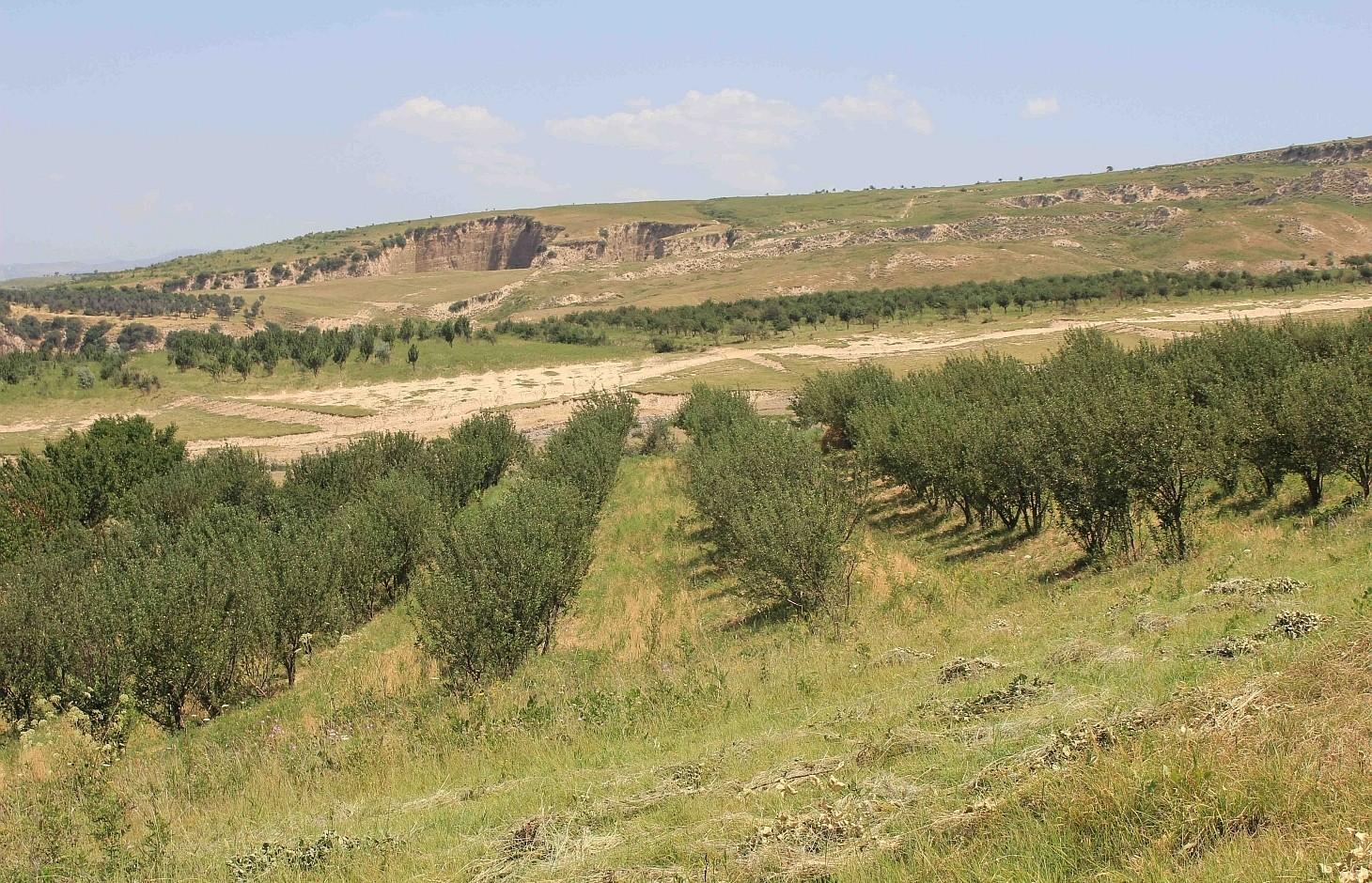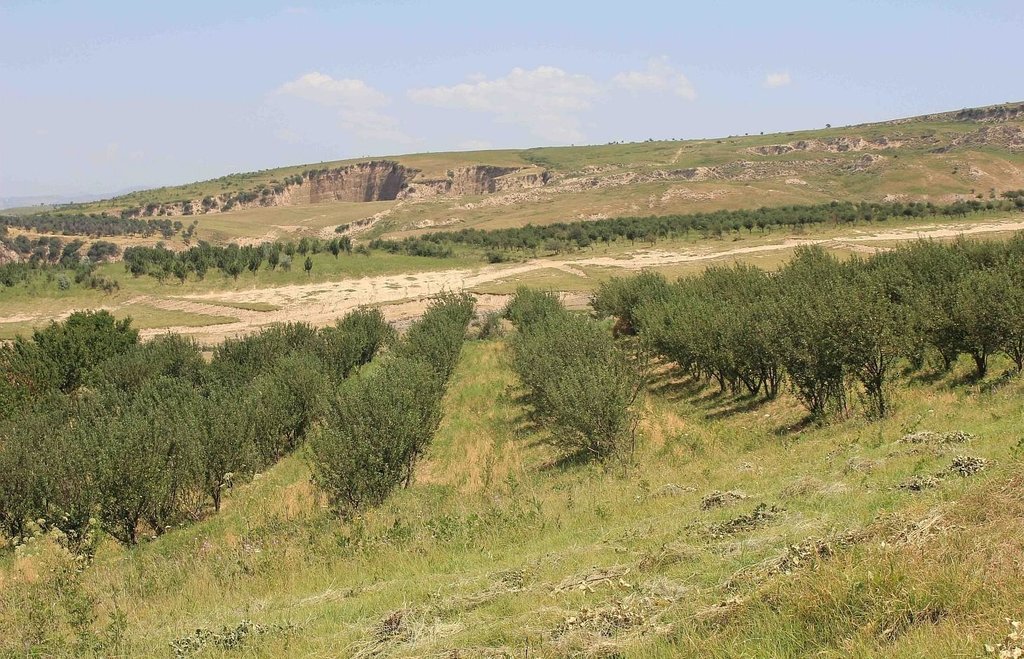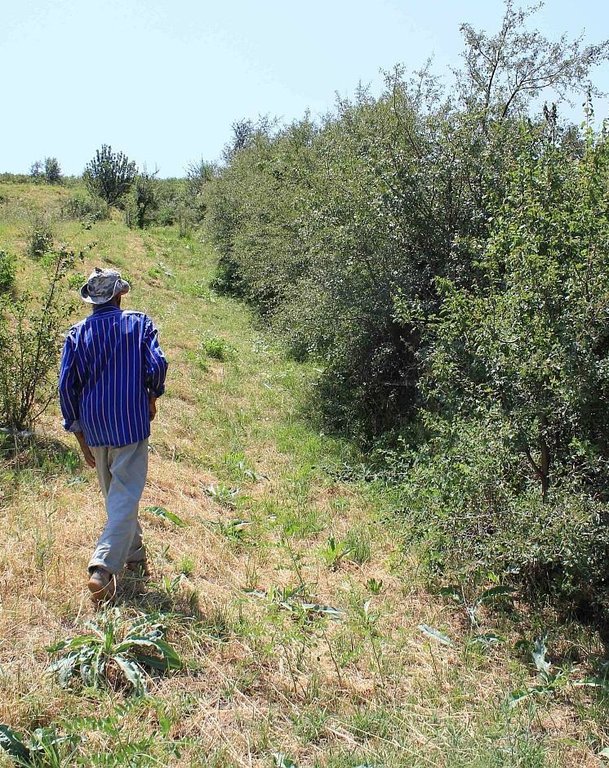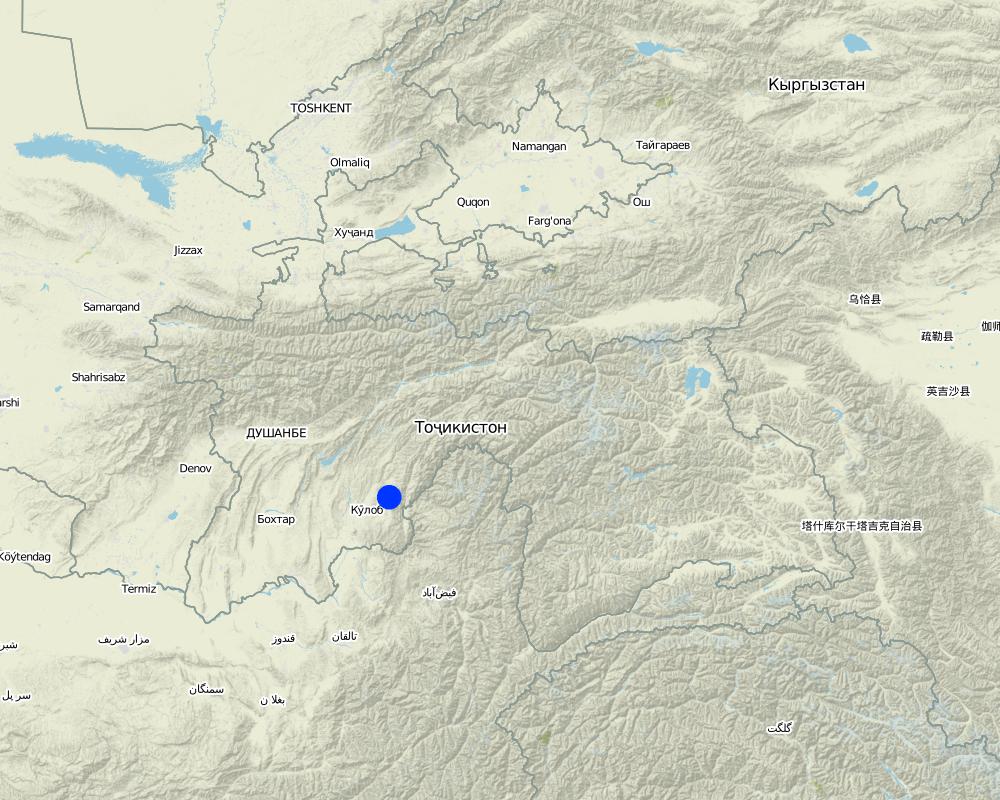Mixed fruit tree orchard with intercropping of Esparcet and annual crops in Muminabad District [塔吉克斯坦]
- 创建:
- 更新:
- 编制者: Malgorzata Conder
- 编辑者: –
- 审查者: Laura Ebneter, Alexandra Gavilano, Fabian Ottiger
Bog
technologies_1128 - 塔吉克斯坦
- Mixed fruit tree orchard with intercropping of Esparcet and annual crops in Muminabad District: Dec. 28, 2016 (inactive)
- Mixed fruit tree orchard with intercropping of Esparcet and annual crops in Muminabad District: May 31, 2017 (inactive)
- Mixed fruit tree orchard with intercropping of Esparcet and annual crops in Muminabad District: June 2, 2017 (inactive)
- Mixed fruit tree orchard with intercropping of Esparcet and annual crops in Muminabad District: Aug. 4, 2019 (public)
查看章节
全部展开 全部收起1. 一般信息
1.2 参与该技术评估和文件编制的资源人员和机构的联系方式
SLM专业人员:
有助于对技术进行记录/评估的机构名称(如相关)
NCCR North-South (NCCR North-South) - 吉尔吉斯斯坦有助于对技术进行记录/评估的机构名称(如相关)
CARITAS (Switzerland) - 瑞士1.3 关于使用通过WOCAT记录的数据的条件
编制者和关键资源人员接受有关使用通过WOCAT记录数据的条件。:
是
2. SLM技术的说明
2.1 技术简介
技术定义:
Orchard based agroforestry established on the hill slopes of Muminabad
2.2 技术的详细说明
说明:
Between 1993 and 94 an individual farmer initiated an orchard by planting a mix of fruit trees, such as apricots, walnuts, cherries, almonds and mostly apple trees in the rainfed hill zones of Muminabad District.
In the first couple of years 416 newly planted seedlings were watered manually: water was brought by trucks near to the plot and distributed to the seedlings with buckets. The orchard was established on the existing grazing land and therefore the seedlings had to be secured with a fence from livestock grazing nearby. First hard wire was used for fencing. Simultaneously, hawthorns (Dulona in Tajik) were planted along the fence in order to provide even stronger protection and establish a live fence for the future. Now, the fruit trees are fully-grown and fruits can be harvested every year. The farmer prunes trees annually, which is the key for fruit production. The farmer pointed out that in rainfed areas soils contain less nutrients and usually big trees do not produce high yield. Furthermore, pruned tree branches are used as firewood. The farmer also applies the pesticides B52 and B58, three times a year in the months of April, May and June. The total area of the plot is 1.03 hectares, whereof 0.60 hectares are orchard; Esparcet is covering roughly 0.30 hectares, 0.07 hectare is for haymaking and the rest of the 0.06 hectares is used for growing chickpea and wheat. There is also a road for machinery to pass and to turn around when plowing the land.
Purpose of the Technology: Shortly after the fall of the Soviet Union, the government officials distributed land to the villagers. The farmer always had a big interest to establish a small orchard and he obtained little more than a hectare of land. It is his project for retirement. He and his family worked hard throughout the establishment phase. They experimented by planting a variety of vegetables including melons and watermelons. The wild animals ate many of the vegetables and melons, what resulted in the farmer's idea of intercropping Esparcet.
Establishment / maintenance activities and inputs: According to the farmer, the first two years were very labor intensive and crucial to establish the orchard. He also had to face a challenge posed by the community, as overnight people from the nearby villages stole roughly 100 of his newly planted seedlings. This is one of the reasons why the farmer had to plant hawthorn in order to establish a live fence. In summary: The establishment phase included planting of young seedlings; manually watering for the first two years; plowing in between the tree rows by machinery; building a fence around the plot and planting/sowing hawthorns. Maintenance activities consist of the following activities: planting new seedlings; pruning of existing trees; grafting new sorts of trees, plowing by tractor in between the tree rows annually; chickpea and wheat cultivation; application of chemical pesticides three times a year. For cutting wheat, the farmer gets support from his son and friends. Every day, he goes to his orchard, which is located at a distance of more than 1.5km from his house. When this technology was documented he was about to build a small clay hut in his orchard.
It should be noted that the terrace structure was not implemented at once, but over the years tilling in between the tree rows along the contour lines formed terrace shaped rows.
The structure of terraces has been built over the years by tilling in between tree rows along the contour lines.
Natural / human environment: Muminabad is situated in the southwest of Tajikistan (Khatlon Province) and its hills are covered by loessial soil. Winter temperatures are low and the amount of precipitation is high. Summers are very hot and dry. The growing season lasts from March/ April to September/ October.
2.3 技术照片
2.5 已应用该技术的、本评估所涵盖的国家/地区/地点
国家:
塔吉克斯坦
区域/州/省:
Khatlon, Tajikistan
有关地点的进一步说明:
Muminabad
注释:
Total area covered by the SLM Technology is 0.01 km2.
1.03 ha in total, whereof 0.6 ha is orchard
Map
×2.6 实施日期
如果不知道确切的年份,请说明大概的日期:
- 10-50年前
2.7 技术介绍
详细说明该技术是如何引入的:
- 通过土地使用者的创新
3. SLM技术的分类
3.2 应用该技术的当前土地利用类型
同一土地单元内混合使用的土地::
是
具体说明混合土地使用(作物/放牧/树木):
- 农林业

农田
- 乔木与灌木的种植
乔木和灌木种植 - 指定作物:
- 仁果类(苹果、梨子、柑橘等)
- 核果(桃、杏、樱桃、李子等)
每年的生长季节数:
- 1
具体说明:
Longest growing period in days: 180Longest growing period from month to month: April-Sept/oct
采用间作制度了吗?:
是
如果是,说明哪些作物是间作的:
wheat, chickpeas

牧场
粗放式放牧:
- 半游牧畜牧业

森林/林地
注释:
Major land use problems (compiler’s opinion): Soil erosion by water, heavy rainfalls, absence of vegetative cover on the hill slopes.
Major land use problems (land users’ perception): Soil erosion by water, extensive grazing, gully erosion.
3.4 供水
该技术所应用土地的供水:
- 混合雨水灌溉
3.6 包含该技术的可持续土地管理措施

植物措施
- V1:乔木和灌木覆盖层

管理措施
- M2:改变管理/强度级别
注释:
Type of vegetative measures: aligned: -contour
3.7 该技术强调的主要土地退化类型

土壤水蚀
- Wt:表土流失/地表侵蚀
- Wg:冲沟侵蚀/沟蚀
注释:
Main causes of degradation: soil management (Extensive grazing led to a reduction of soil cover, which is the major source of erosion), deforestation / removal of natural vegetation (incl. forest fires) (Removal of trees left the soil unprotected against precipitation and extreme weather events), over-exploitation of vegetation for domestic use (Trees were cut as firewood for fuel consumption), overgrazing, land tenure (Land abandonment after Soviet collapse), governance / institutional (Lacking istitutional support)
Secondary causes of degradation: Heavy / extreme rainfall (intensity/amounts) (More extreme rainfall events), floods (As a result of extreme events there are more floods in the region)
3.8 防止、减少或恢复土地退化
具体数量名该技术与土地退化有关的目标:
- 防止土地退化
- 减少土地退化
注释:
Main goals: prevention of land degradation, mitigation / reduction of land degradation
Secondary goals: rehabilitation / reclamation of denuded land
4. 技术规范、实施活动、投入和成本
4.1 该技术的技术图纸
技术规范(与技术图纸相关):
The fenced plot is mainly used for the orchard intercropped with chickpea, flax and wheat. Esparcet and grass for haymaking covers only a small part of the plot. The part on the left handside is also used to turn the tractor when ploughing, which is why this part is affected by soil erosion and rills. The whole property is fenced by hawthorns (dulona). The orchard has a terrace-like structure due to annual plowing by tractor.
Location: Sarmaydon 2. Muminabad
Technical knowledge required for field staff / advisors: moderate
Technical knowledge required for land users: moderate
Main technical functions: control of raindrop splash, control of dispersed runoff: retain / trap, control of dispersed runoff: impede / retard, improvement of ground cover, water harvesting / increase water supply, increase of biomass (quantity)
Secondary technical functions: improvement of surface structure (crusting, sealing), improvement of topsoil structure (compaction), increase in organic matter, increase / maintain water stored in soil, reduction in wind speed
Aligned: -contour
Number of plants per (ha): 416
Vertical interval between rows / strips / blocks (m): 3
Vertical interval within rows / strips / blocks (m): 3.5
Fruit trees / shrubs species: apple, apricot, pear, cherry
Other species: intercropped with chickpea and wheat
作者:
Q. Shokirov
日期:
12-07-2012
4.2 有关投入和成本计算的一般信息
其它/国家货币(具体说明):
Somoni
如相关,注明美元与当地货币的汇率(例如1美元=79.9巴西雷亚尔):1美元=:
4.83
注明雇用劳工的每日平均工资成本:
12.40
4.3 技术建立活动
| 活动 | 时间(季度) | |
|---|---|---|
| 1. | Digging a deep barrier for protection around the plot with a bulldozer, 1 day | once (1993) |
| 2. | Plowing in between the rows by tractor, labor, petrol and rent for one day | once (1993) |
| 3. | Planting fruit trees, 3 days by 3 persons (3-5 Somoni per seedling, 3 Som/ seedling planting) | once (1993) |
| 4. | Watering young seedlings for the first couple of years by truck (60 TJS per truck) | one day a week/ 50 times a year |
| 5. | Construction of fence with hard wire and haw thorn (approx. 320m) | once |
| 6. | Buying and replanting of 100 stolen fruit seedlings | once |
4.4 技术建立所需要的费用和投入
| 对投入进行具体说明 | 单位 | 数量 | 单位成本 | 每项投入的总成本 | 土地使用者承担的成本% | |
|---|---|---|---|---|---|---|
| 劳动力 | Labour | ha | 1.0 | 4629.333 | 4629.33 | 100.0 |
| 设备 | Machine use | ha | 1.0 | 227.833 | 227.83 | 100.0 |
| 设备 | Petrol | l | 20.0 | 1.14 | 22.8 | 100.0 |
| 植物材料 | Seedlings | Pieces | 516.0 | 0.621 | 320.44 | 100.0 |
| 施工材料 | Hard wire and pillars | m | 320.0 | 1.4556 | 465.79 | 100.0 |
| 技术建立所需总成本 | 5666.19 | |||||
| 技术建立总成本,美元 | 1173.12 | |||||
注释:
Duration of establishment phase: 24 month(s)
4.5 维护/经常性活动
| 活动 | 时间/频率 | |
|---|---|---|
| 1. | Tractor ploughing, labor, petrol and rent, 1-2 hours, 2 persons | spring, once a year |
| 2. | Soil loosening around trees, 5-6 days, 3-4 persons | spring, once a year |
| 3. | Pruning of the approx. 400 fruit trees (3 TJS per tree) | every year |
| 4. | Bringing water from village and watering (40 liters a day,20l on each donkey, 3 h for walking and watering) | every day |
| 5. | Applying pesticides, 1 person, 7 days (5 hours per day) | Three times a year: April, May, June |
| 6. | Sowing wheat and chickpea (1 person, 2 hours) | spring, once a year |
| 7. | Cutting wheat and chickpea (2 persons, 4 hours) | autumn, once |
| 8. | Harvesting fruit trees (3.6 TJS per fruit tree) | autumn, once a year |
4.6 维护/经常性活动所需要的费用和投入(每年)
| 对投入进行具体说明 | 单位 | 数量 | 单位成本 | 每项投入的总成本 | 土地使用者承担的成本% | |
|---|---|---|---|---|---|---|
| 劳动力 | Labour | ha | 1.0 | 4493.5 | 4493.5 | 100.0 |
| 设备 | Machine use | ha | 1.0 | 10.3 | 10.3 | 100.0 |
| 设备 | Petrol | l | 20.0 | 1.14 | 22.8 | 100.0 |
| 植物材料 | Pesticides | kg | 0.25 | 186.0 | 46.5 | 100.0 |
| 植物材料 | Seeds | pc | 1.0 | 3.7 | 3.7 | 100.0 |
| 技术维护所需总成本 | 4576.8 | |||||
| 技术维护总成本,美元 | 947.58 | |||||
4.7 影响成本的最重要因素
描述影响成本的最决定性因素:
The technology was established during the Soviet Union and most of the expenses were calculated on the price basis of that time. If technology is priced by current prices, the total sum would be very high and no farmer would be able to afford. Thus, current prices were not identified. Nowadays, machinery cost, buying hard wire for fencing and buying seedlings would be the most costly factors.
5. 自然和人文环境
5.1 气候
年降雨量
- < 250毫米
- 251-500毫米
- 501-750毫米
- 751-1,000毫米
- 1,001-1,500毫米
- 1,501-2,000毫米
- 2,001-3,000毫米
- 3,001-4,000毫米
- > 4,000毫米
农业气候带
- 半湿润
Thermal climate class: temperate
5.2 地形
平均坡度:
- 水平(0-2%)
- 缓降(3-5%)
- 平缓(6-10%)
- 滚坡(11-15%)
- 崎岖(16-30%)
- 陡峭(31-60%)
- 非常陡峭(>60%)
地形:
- 高原/平原
- 山脊
- 山坡
- 山地斜坡
- 麓坡
- 谷底
垂直分布带:
- 0-100 m a.s.l.
- 101-500 m a.s.l.
- 501-1,000 m a.s.l.
- 1,001-1,500 m a.s.l.
- 1,501-2,000 m a.s.l.
- 2,001-2,500 m a.s.l.
- 2,501-3,000 m a.s.l.
- 3,001-4,000 m a.s.l.
- > 4,000 m a.s.l.
5.3 土壤
平均土层深度:
- 非常浅(0-20厘米)
- 浅(21-50厘米)
- 中等深度(51-80厘米)
- 深(81-120厘米)
- 非常深(> 120厘米)
土壤质地(表土):
- 粗粒/轻(砂质)
表土有机质:
- 中(1-3%)
5.4 水资源可用性和质量
地下水位表:
> 50米
地表水的可用性:
匮乏/没有
水质(未处理):
不可用
5.5 生物多样性
物种多样性:
- 中等
5.6 应用该技术的土地使用者的特征
生产系统的市场定位:
- 生计(自给)
非农收入:
- 收入的10-50%
相对财富水平:
- 平均水平
个人或集体:
- 个人/家庭
机械化水平:
- 手工作业
- 机械化/电动
性别:
- 女人
- 男人
说明土地使用者的其他有关特征:
Population density: 100-200 persons/km2
Annual population growth: 1% - 2%
40% of the land users are average wealthy.
5.7 应用该技术的土地使用者使用的平均土地面积
- < 0.5 公顷
- 0.5-1 公顷
- 1-2 公顷
- 2-5公顷
- 5-15公顷
- 15-50公顷
- 50-100公顷
- 100-500公顷
- 500-1,000公顷
- 1,000-10,000公顷
- > 10,000公顷
这被认为是小规模、中规模还是大规模的(参照当地实际情况)?:
- 小规模的
5.8 土地所有权、土地使用权和水使用权
土地所有权:
- 州
土地使用权:
- 租赁
注释:
Land ownership is based on the land user certificate conferred by the government.
5.9 进入服务和基础设施的通道
健康:
- 贫瘠
- 适度的
- 好
教育:
- 贫瘠
- 适度的
- 好
技术援助:
- 贫瘠
- 适度的
- 好
就业(例如非农):
- 贫瘠
- 适度的
- 好
市场:
- 贫瘠
- 适度的
- 好
能源:
- 贫瘠
- 适度的
- 好
道路和交通:
- 贫瘠
- 适度的
- 好
饮用水和卫生设施:
- 贫瘠
- 适度的
- 好
金融服务:
- 贫瘠
- 适度的
- 好
6. 影响和结论性说明
6.1 该技术的现场影响
社会经济效应
生产
作物生产
饲料生产
饲料质量
木材生产
生产区域
水资源可用性和质量
灌溉用水需求
收入和成本
农业投入费用
农业收入
收入来源的多样性
工作量
社会文化影响
食品安全/自给自足
娱乐机会
冲突缓解
生态影响
水循环/径流
地表径流
蒸发
土壤
土壤水分
土壤覆盖层
土壤流失
土壤结壳/密封
土壤压实
土壤有机物/地下C
生物多样性:植被、动物
生物量/地上C
栖息地多样性
6.2 该技术的场外影响已经显现
下游洪水
缓冲/过滤能力
6.3 技术对渐变气候以及与气候相关的极端情况/灾害的暴露和敏感性(土地使用者认为的极端情况/灾害)
渐变气候
渐变气候
| 季节 | 增加或减少 | 该技术是如何应对的? | |
|---|---|---|---|
| 年温度 | 增加 | 不好 |
气候有关的极端情况(灾害)
气象灾害
| 该技术是如何应对的? | |
|---|---|
| 局地暴雨 | 好 |
| 局地风暴 | 好 |
气候灾害
| 该技术是如何应对的? | |
|---|---|
| 干旱 | 不好 |
水文灾害
| 该技术是如何应对的? | |
|---|---|
| 比较和缓的(河道)洪水 | 不好 |
6.4 成本效益分析
技术收益与技术建立成本相比如何(从土地使用者的角度看)?
短期回报:
中性/平衡
长期回报:
非常积极
技术收益与技术维护成本/经常性成本相比如何(从土地使用者的角度看)?
短期回报:
中性/平衡
长期回报:
非常积极
注释:
After 6 years income is very comparable to the establishment cost
6.5 技术采用
注释:
98% of land user families have adopted the Technology with external material support
2% of land user families have adopted the Technology without any external material support
5 land user families have adopted the Technology without any external material support
There is a little trend towards spontaneous adoption of the Technology
Comments on adoption trend: Cost of the technology is very expensive, which discourages farmers to implement orchards based agroforestry.
6.7 该技术的优点/长处/机会
| 土地使用者眼中的长处/优势/机会 |
|---|
|
Grafting trees especially apple and pear trees on native hawthorns is an affordable and sustainable way of creating orchards in semi-arid areas with rainfed agriculture. Hawthorn is a plant adjusted to dry areas with strong and deep roots, which endures the hot summer months. How can they be sustained / enhanced? Tree nursery workshops and educational programmes about local species through seed associations |
|
Intercropping wheat, chickpea, flax and Esparcet in between the tree rows gives an extra economic incentive and also improves land productivity. How can they be sustained / enhanced? Knowledge raising, inspection of those good practices by other farmers |
| Haymaking with natural grass and Esparcet provide the farmer with an opportunity to produce hay for the winter months for his livestock, so that he does not need to purchase it from the market at high costs. |
| The farmer practices pruning on a regular basis to keep the trees in good shape for better fruit production, but also to have sufficient fire wood for the winter months. |
| 编制者或其他关键资源人员认为的长处/优势/机会 |
|---|
|
Compared to other plots with orchards there is almost no soil erosion which is mainly due to good land management practices, e.g. the slow building up of terraces. How can they be sustained / enhanced? Sustain the practice of contour ploughing |
6.8 技术的弱点/缺点/风险及其克服方法
| 土地使用者认为的弱点/缺点/风险 | 如何克服它们? |
|---|---|
| It is expensive to establish such orchards nowadays, because of the high cost for purchasing seedlings and hiring other machinery. | See comment below |
| Growing new seedlings and grafting trees is a cheaper way of establishing a new orchard, but it is not commonly practiced among the farmers in the region. | There should be a tree nursery workshop in order to raise awareness among the young generation of farmers. |
| 编制者或其他关键资源人员认为的弱点/缺点/风险 | 如何克服它们? |
|---|---|
| Since the orchard is located in a rainfed area, hot summer months make the technology vulnerable to drought. To some extent the technology is tolerant to dryer summers, but maybe not for prolonged droughts (e.g. two successive drought). |
The farmer has suggested that grafting fruit trees on native hawthorn (dulona) trees has potential for farmers when establishing orchards in rainfed areas. In extreme events (extremely dry years), the farmer brings water for supplementary irrigation from his house by donkey. |
7. 参考和链接
7.1 信息的方法/来源
链接和模块
全部展开 全部收起链接
无链接
模块
无模块





